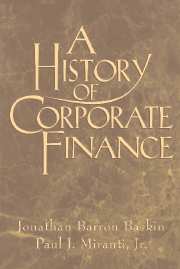Book contents
- Frontmatter
- Contents
- Preface
- Introduction: History and the Modern Theory of Finance
- Part I The Preindustrial World
- Part II The Rise of Modern Industry
- Part III The Transition to the Contemporary Era
- Epilogue
- APPENDIX A Finance and Informational Asymmetries in the Ancient World
- APPENDIX B International Patterns of Corporate Governance
- Index
Epilogue
Published online by Cambridge University Press: 22 March 2010
- Frontmatter
- Contents
- Preface
- Introduction: History and the Modern Theory of Finance
- Part I The Preindustrial World
- Part II The Rise of Modern Industry
- Part III The Transition to the Contemporary Era
- Epilogue
- APPENDIX A Finance and Informational Asymmetries in the Ancient World
- APPENDIX B International Patterns of Corporate Governance
- Index
Summary
Two questions remain for this epilogue. First, how can the long-term environmental factors that have invigorated institutional innovation be integrated in a general statement with the traditional firm-specific financial parameters that usually inform decisions about corporate capital structure? Second, what specific patterns of environmentalinstitutional interaction were evident historically?
The Integration of Environmental and Firm-Specific Factors
Concerning the first question, it is appropriate to use the example of the capital structure problem, which has, through time, been sensitive to two sets of variables. Long-term factors have, as we have seen in this study, influenced the capital structure of firms through four dimensions of evolution: social governance structures (including bodies of law and political arrangements); communication modalities; knowledge of science and technology; and knowledge of management. These are important because they facilitate the establishment of financial institutions that enhance the capacity of corporations to concentrate capital and realize gains by reducing risk perceptions, achieving economies of scale and/or scope, overcoming market imperfections, and enabling the entity to accommodate unexpected externalities. Although the influence of these environmental elements is omnipresent, their effects are generally not central in short-run analysis and decision making because they change only over the long term, and these changes are irregular in both rate and scope. Thus, because they generally exhibit in the short run a stable rather than a dynamic character, they are rarely seen as exerting much direct or identifiable influence over financial planning decisions.
- Type
- Chapter
- Information
- A History of Corporate Finance , pp. 303 - 312Publisher: Cambridge University PressPrint publication year: 1997
- 1
- Cited by



